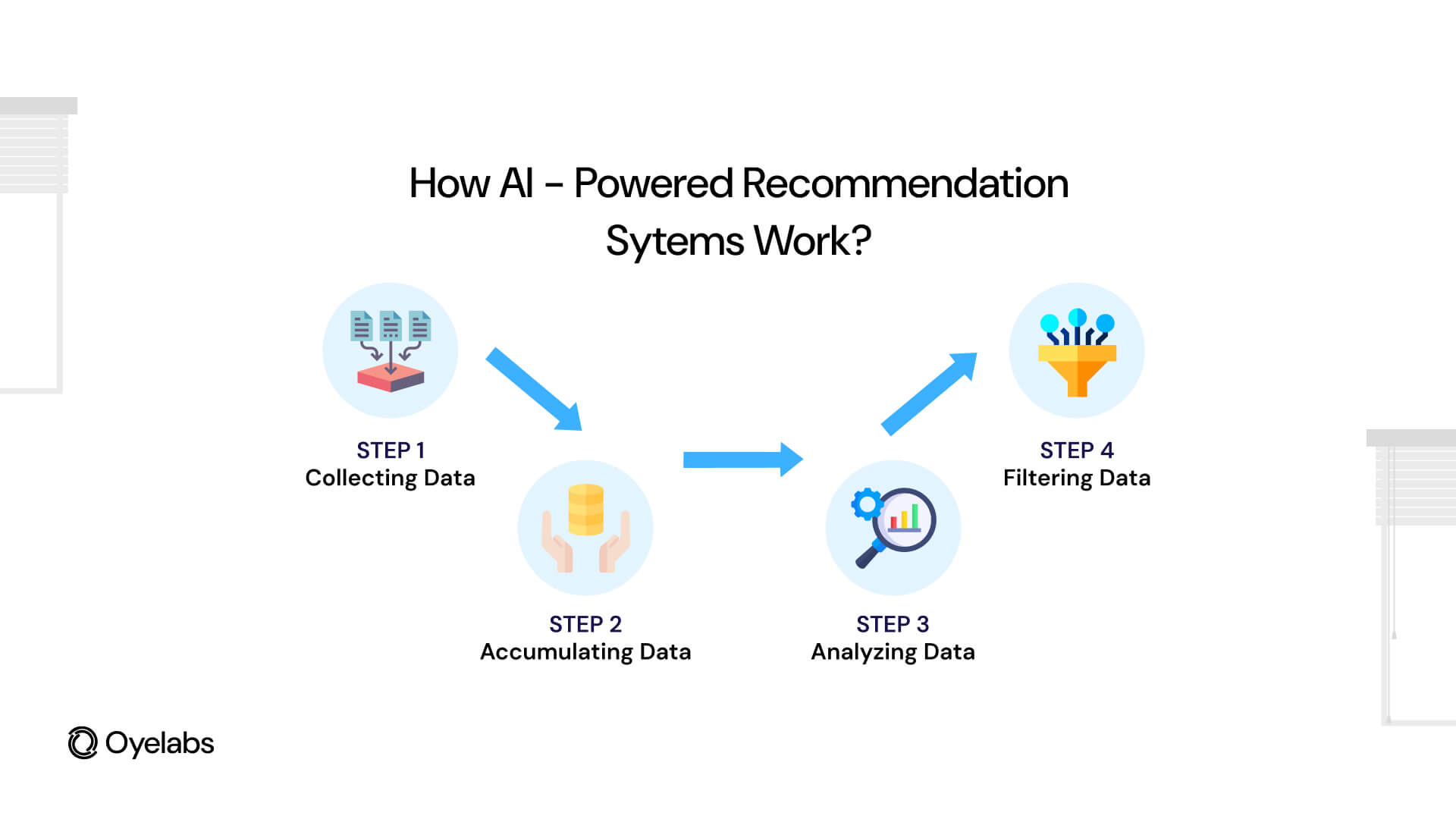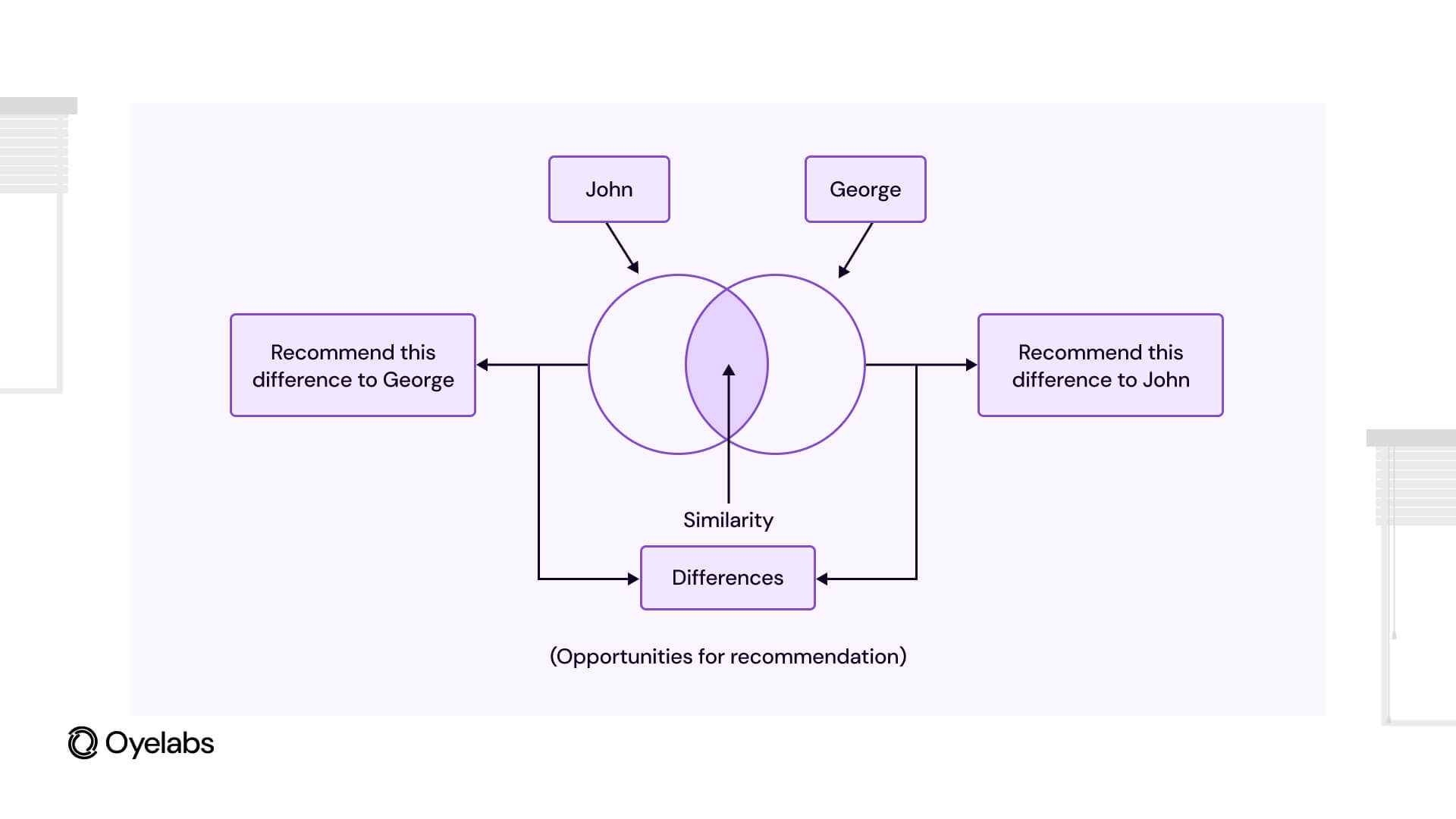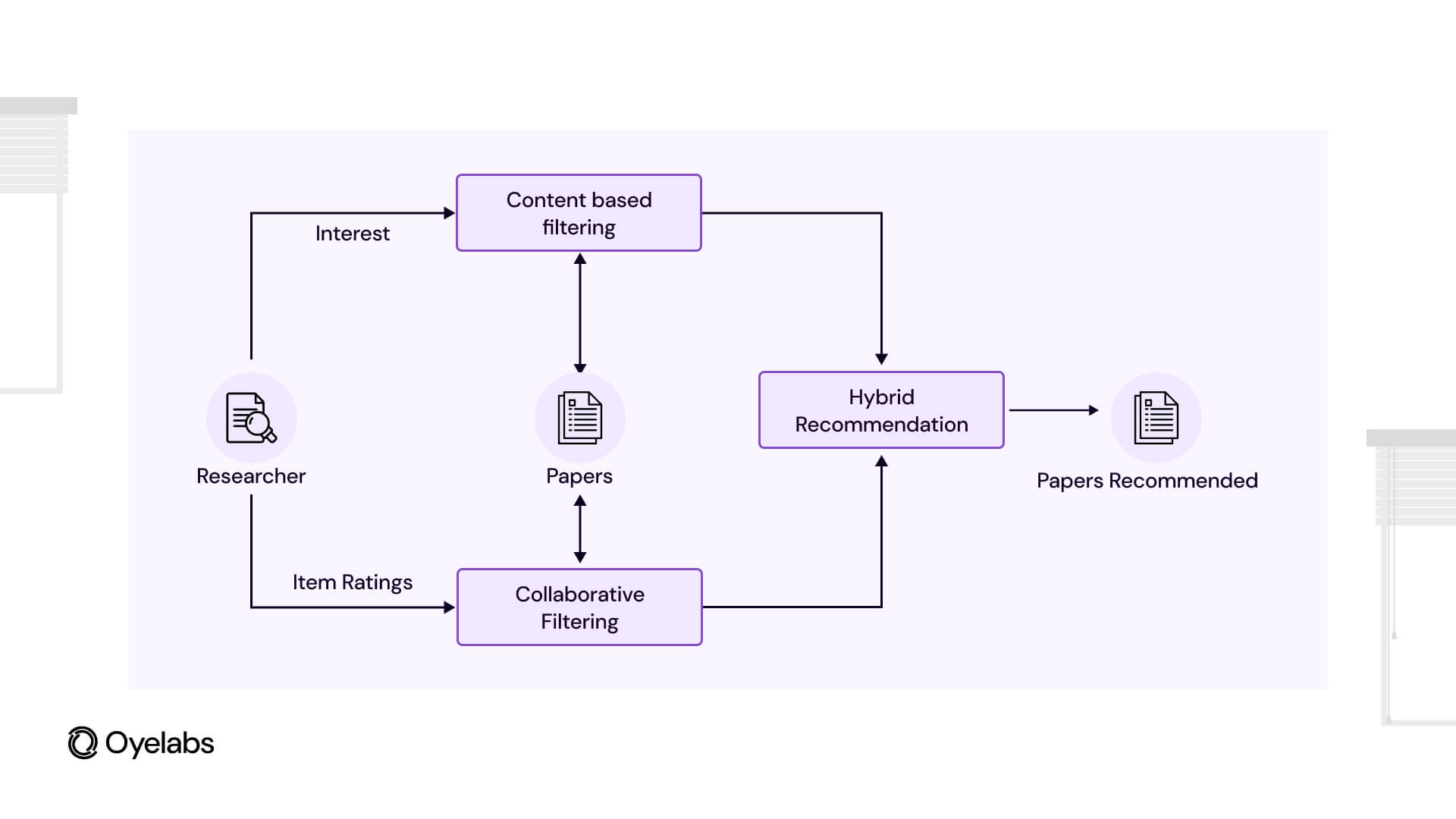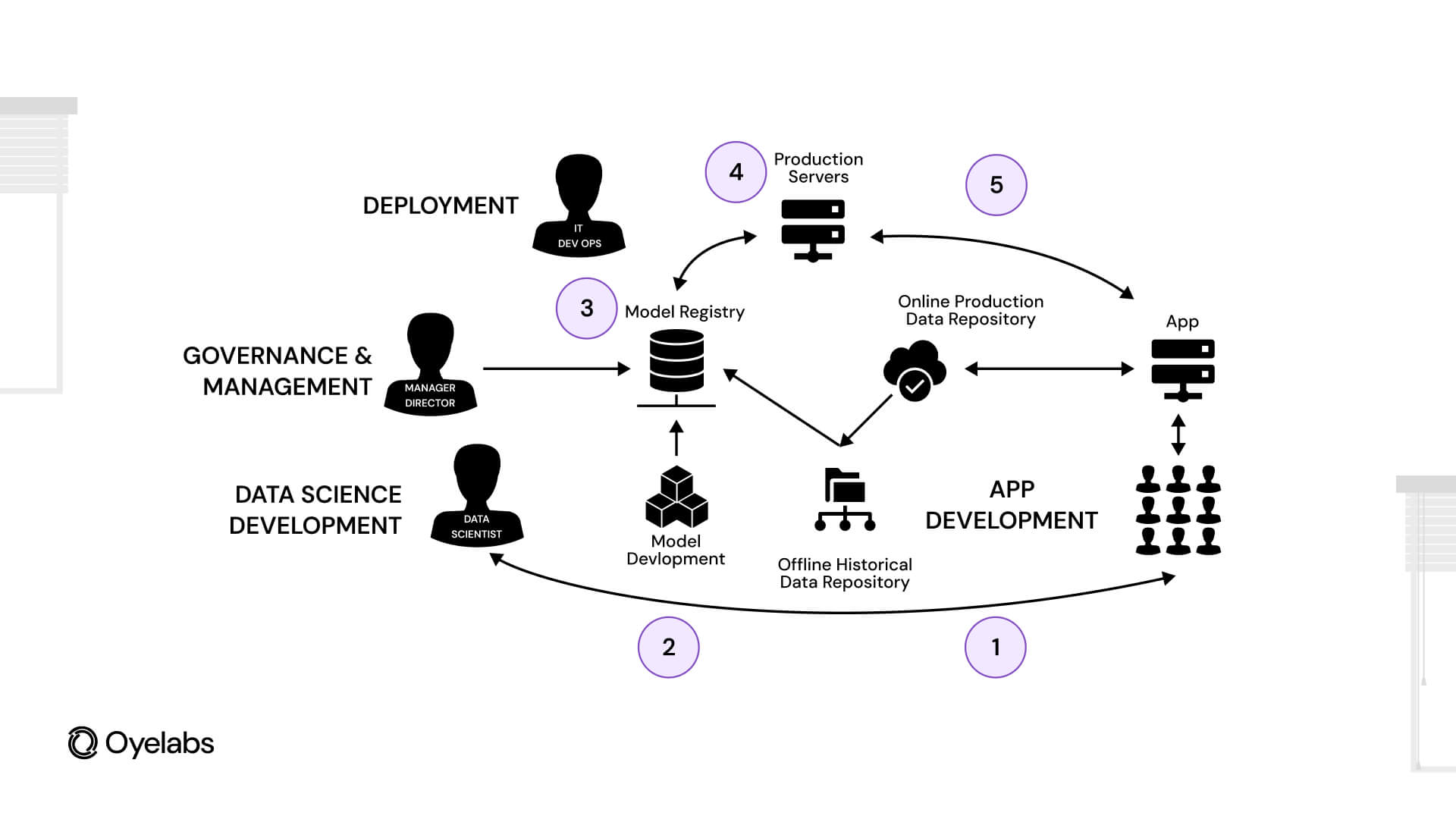Building AI-Powered Recommendation System – A Complete Guide
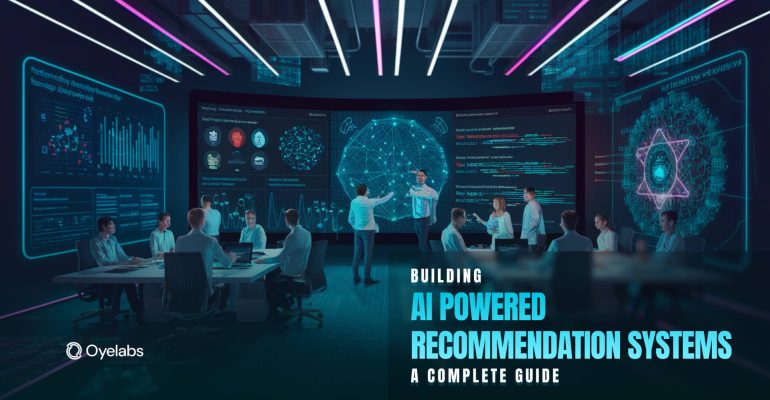
Building AI-Powered Recommendation System – A Complete Guide
Last Updated on July 11, 2025
The internet has made shopping and content consumption easier, but the vast number of choices can overwhelm consumers. To address this, businesses are turning to AI-powered recommendation systems that personalize suggestions based on user behavior and preferences. These systems help businesses stand out in competitive markets by increasing sales and enhancing customer satisfaction. For example, McKinsey reports that algorithmic recommendations drive 35% of Amazon’s sales and 75% of Netflix’s content consumption.
AI is reshaping industries by improving the user experience through personalized suggestions. These systems also help businesses boost revenue through upselling and building customer loyalty. In this guide, we’ll explore how to build an AI-powered recommendation system as a robust AI solution and the best practices for successful implementation.
What is an AI-Based Recommendation System?
An AI-powered recommendation system, or recommendation engine, leverages machine learning algorithms to analyze user data and provide personalized suggestions for products, services, or content. These systems are essential for businesses looking to enhance user engagement, increase efficiency, and drive revenue by offering tailored recommendations.
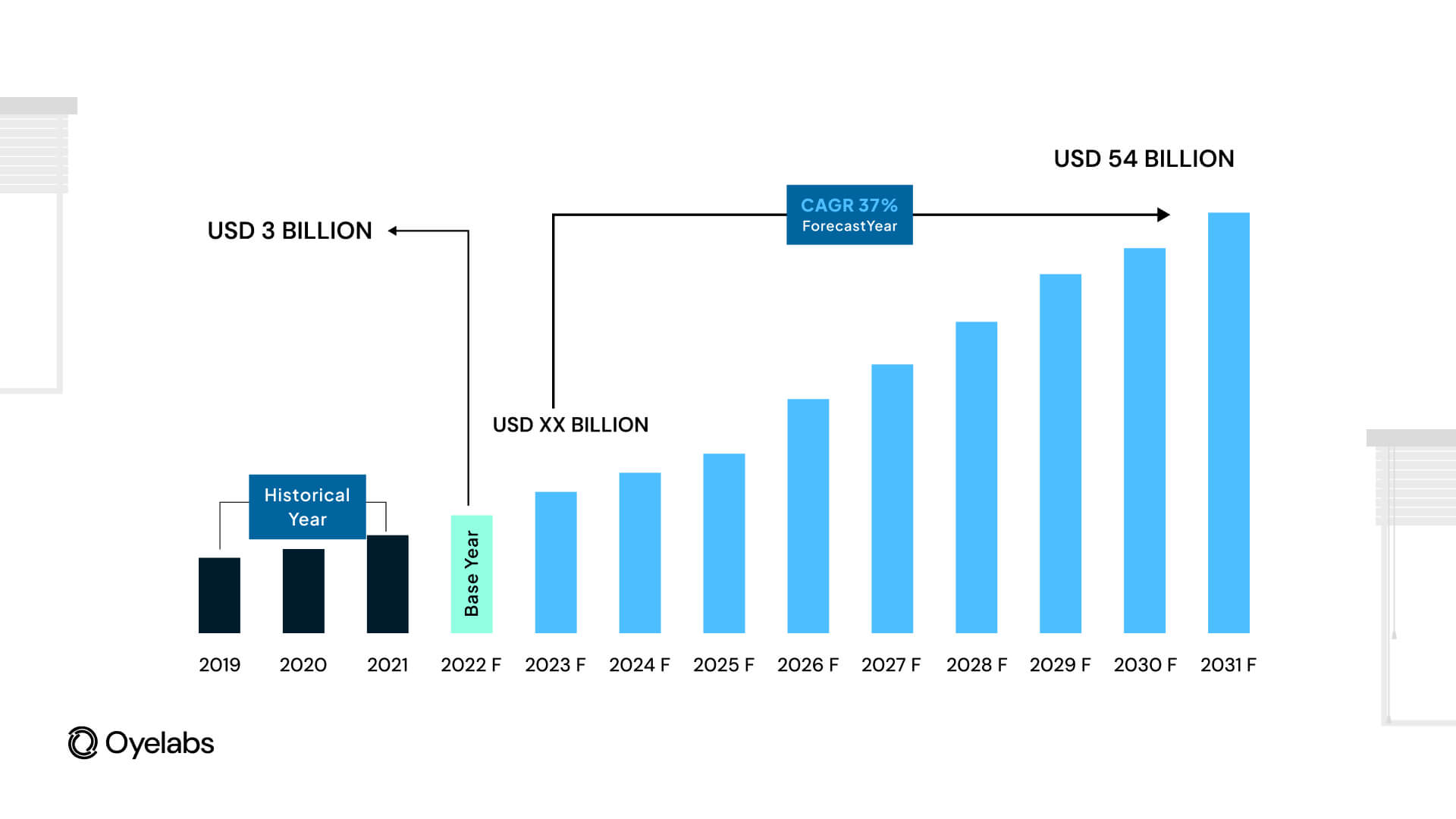
How Does an AI-Based Recommendation System work?
At its core, an AI-based recommendation system processes vast datasets to identify patterns and generate relevant recommendations. The system operates through a structured four-step process:
Data Collection
The initial phase involves gathering user data, which can be explicit (e.g., ratings, reviews) or implicit (e.g., browsing history, purchase records, search logs). This comprehensive data collection enables the system to construct detailed user profiles, facilitating accurate recommendations.
Behavioral data is particularly valuable, offering insights into user preferences without requiring direct input. Analyzing this data can be complex due to its volume and the need to filter out irrelevant information. The effectiveness of the recommendation system improves with the quantity and quality of data collected. For instance, intelligent recommender systems have been shown to deliver an average increase of 22.66% in conversion rates for web products.
Data Storage
Efficient storage solutions are essential to manage the vast amounts of data involved. The choice of storage—be it NoSQL databases, traditional SQL databases, or cloud-based systems—depends on factors like data type, accessibility, and integration needs.
Cloud-based solutions, such as Cloud SQL, are often preferred for their scalability and managed services, allowing businesses to focus on refining recommendations rather than handling infrastructure. In 2023, cloud deployment models dominated the AI-based recommendation system market, accounting for 68.5% of the deployment mode segment.
Data Analysis
Post-storage, the data undergoes analysis to extract actionable insights. Depending on the application, analysis can be:
- Real-time Analysis: Offers immediate recommendations based on current user actions, enhancing engagement.
- Batch Analysis: Processes data at set intervals, suitable for periodic updates like daily or weekly recommendations.
- Near-Real-Time Analysis: Balances immediacy and data processing demands, updating recommendations frequently within a user session.
Advanced data processing tools are employed to handle and analyze large datasets efficiently, ensuring that recommendations remain relevant and timely.
Data Filtering & Recommendation Generation
The final step involves filtering data to produce personalized recommendations. Common filtering techniques include:
- Content-Based Filtering: Recommends items with attributes similar to those a user has interacted with previously.
- Collaborative Filtering: Suggests items based on preferences of users with similar interests.
- Cluster-Based Filtering: Groups items into clusters based on characteristics and recommends items from clusters aligned with user preferences.
Algorithms such as K-Nearest Neighbors, Jaccard’s Coefficient, Dijkstra’s Algorithm, and Cosine Similarity are utilized to assess relationships between users and items, facilitating accurate recommendations.
The AI-based recommendation system market has experienced significant growth, valued at USD 2.8 billion in 2023 and projected to reach USD 34.4 billion by 2033, with a Compound Annual Growth Rate (CAGR) of 28.5%.
In summary, AI-based recommendation systems are pivotal in delivering personalized user experiences, driving engagement, and enhancing business performance. By systematically collecting, storing, analyzing, and filtering data, these systems provide relevant and timely suggestions, benefiting both users and businesses across various industries.
Also Read: AI Development Costs Explained
Types of Recommendation Systems
Recommendation systems play a crucial role in enhancing user experiences by personalizing suggestions based on individual preferences and behaviors. There are several types of recommendation systems, each with its strengths and applications. These systems primarily rely on machine learning algorithms to analyze user data, predict preferences, and suggest relevant content, products, or services. Below are the most common types of recommendation systems:
Collaborative Filtering Systems
Collaborative filtering is one of the most widely used techniques in recommendation systems. It operates on the principle of predicting a user’s preferences based on the behavior and preferences of others. The core idea is simple: if two users share similar preferences in one area, they are likely to have similar interests in other areas as well. Collaborative filtering can be broken down into two primary approaches:
- Memory-Based (Neighborhood) Collaborative Filtering
This approach relies on user-item interaction data to identify similar users and suggest items that those similar users have liked. For example, YouTube uses this method to recommend videos based on what similar users have watched. In fact, a PwC study found that 80% of users are influenced by recommendations when making purchases online, making this approach highly effective for user engagement. - Model-Based Collaborative Filtering
This method employs machine learning algorithms to predict user preferences. Models like decision trees or latent factor models are used to generate predictions based on user behavior. CourseEra uses this approach to recommend courses that other learners have completed after similar ones.
Advantages of Collaborative Filtering:
- Scalability: Collaborative filtering can easily handle large datasets and scale with user bases.
- Discovery of New Items: By relying on the collective behavior of users, this method often introduces users to products or content they might not have discovered otherwise.
However, collaborative filtering faces challenges such as the “cold start” problem, where new users or items may not have enough data to generate accurate recommendations.
Content-Based Systems
Content-based recommendation systems focus on suggesting items similar to those a user has previously interacted with, based on the attributes of the items themselves. Unlike collaborative filtering, content-based systems don’t rely on other users’ data but instead use the individual’s past interactions to generate suggestions.
For example, Amazon uses content-based recommendations to suggest products that are similar to those a user has previously purchased. Similarly, Spotify suggests music based on genres or artists the user has enjoyed in the past. In fact, Spotify’s recommendation engine plays a crucial role in user retention, with more than 30% of all streams on the platform attributed to recommendations.
Advantages of Content-Based Systems:
- Relevance: Recommendations are highly tailored to the user’s specific preferences, making them more relevant and personal.
- Quick to Implement: This approach doesn’t require a large amount of user interaction history, making it suitable for scenarios with limited user data.
However, content-based systems can lead to repetitive recommendations and may not encourage users to explore beyond their typical preferences.
Hybrid Recommendation Systems
Hybrid recommendation systems aim to overcome the limitations of individual models by combining multiple recommendation techniques. These systems often integrate both collaborative filtering and content-based methods, resulting in more robust and accurate recommendations.
For instance, Netflix uses a hybrid system that combines user behavior (collaborative filtering) with content attributes (like genre, director, and actors) to provide users with more relevant movie recommendations. The hybrid approach can be implemented in two main ways:
- Parallel Hybrid Systems: Multiple recommendation systems work in parallel, and their outputs are combined to generate a final recommendation.
- Sequential Hybrid Systems: A single recommendation engine generates an output, which is passed to another engine to refine the results.
Advantages of Hybrid Systems:
- Increased Accuracy: By leveraging the strengths of multiple models, hybrid systems offer more accurate and personalized recommendations.
- Versatility: These systems are adaptable and can handle a wider range of user behaviors and item types.
Netflix’s success with hybrid recommendations is evident, as the platform generates over 80% of its viewed content based on personalized suggestions. Hybrid systems do, however, tend to be more complex and resource-intensive to implement and maintain.
Knowledge-Based Systems
Knowledge-based recommendation systems provide recommendations based on a user’s explicit needs and criteria, often relying on expert knowledge. These systems define rules that match a user’s preferences with item characteristics, without depending solely on past interactions or user behavior.
For example, Zillow offers property recommendations based on user-defined filters such as budget, location, and size. Similarly, Airbnb suggests properties based on the number of guests, dates, and other specific preferences. According to Forrester, 57% of users find knowledge-based recommendations highly valuable for making informed decisions.
Advantages of Knowledge-Based Systems:
- Clear Explanations: Since the recommendations are based on predefined rules, users can easily understand why a particular suggestion was made, fostering trust.
- No Cold Start Issues: These systems can recommend items even when there’s minimal user interaction history, making them ideal for complex or infrequent purchases.
However, building knowledge-based systems requires significant resources and domain expertise, which can make them more expensive to develop.
Also Read: AI in Surveillance System
Benefits of an AI Recommendation System
Personalization
AI-powered recommendation systems excel at personalizing user experiences by analyzing extensive datasets to understand individual preferences. By leveraging browsing history, purchase behavior, and interaction patterns, AI can deliver highly relevant suggestions that keep users engaged. For example, Netflix reports that 80% of its content consumption is driven by AI-powered recommendations, ensuring users discover shows and movies they are likely to enjoy. Similarly, Spotify’s recommendation engine influences 30% of all streams, curating personalized playlists based on listening habits. This deep level of personalization not only improves user satisfaction but also enhances platform loyalty, keeping customers engaged for longer.
Boost Revenue
AI-driven recommendations significantly impact business revenue by increasing customer engagement and sales. Personalized product recommendations encourage upselling and cross-selling, leading to higher purchase rates. According to FactFinder, businesses that implement AI-powered recommendation engines see an average revenue increase of 15%, as users are more likely to buy suggested products that match their interests. Amazon, for instance, attributes 35% of its total sales to AI-driven recommendations, demonstrating the direct financial benefits of personalization. By predicting user preferences and delivering targeted suggestions, businesses can enhance the shopping experience while maximizing revenue potential through increased conversions and larger order values.
Improved Inventory Management
AI-powered recommendation systems assist businesses in optimizing inventory by predicting product demand and customer preferences. By analyzing purchase trends, market behavior, and seasonal demand, AI helps retailers maintain optimal stock levels, reducing the risk of overstocking or stockouts. This leads to increased profitability and improved supply chain efficiency. Walmart employs AI-driven demand forecasting models to enhance its inventory management, minimizing excess stock and ensuring popular products remain available. Such predictive analytics enable businesses to anticipate customer needs, streamline supply chains, and make data-driven restocking decisions, ultimately reducing operational costs and increasing overall efficiency.
Better Content Discovery
In media, entertainment, and e-commerce, AI-driven recommendation systems enhance content discovery by presenting users with relevant articles, videos, and products based on their interests. This keeps users engaged and encourages them to spend more time on a platform. YouTube’s recommendation algorithm is responsible for 70% of the content watched on the platform, demonstrating the power of AI in driving engagement. Similarly, TikTok’s “For You” page curates videos tailored to individual user preferences, making content discovery seamless. By personalizing suggestions, AI ensures that users continuously find relevant and engaging content, increasing platform retention rates and overall user satisfaction.
Enhanced Efficiency
AI simplifies decision-making by presenting users with tailored options, reducing the effort needed to find relevant content or products. Instead of manually searching for items, users receive intelligent recommendations that match their interests, saving time and effort. Google’s AI-powered search algorithms enhance efficiency by providing users with personalized results based on past searches and browsing history. Likewise, LinkedIn recommends job opportunities based on a user’s experience, skills, and industry preferences, streamlining the job search process. This level of automation makes interactions more intuitive, improving user experience and ensuring that relevant options are always at their fingertips.
Reduced Cart Abandonment Rates
Cart abandonment is a major challenge for e-commerce businesses, with an average abandonment rate of 70%. AI-powered recommendation systems help tackle this issue by strategically presenting personalized product suggestions at key moments in the purchasing journey. For instance, Amazon and eBay use AI to send reminders about abandoned carts while suggesting complementary products, increasing the likelihood of conversion. By analyzing browsing behavior and intent signals, AI can predict when a user is likely to abandon their cart and trigger timely incentives, such as personalized discounts or limited-time offers. This proactive approach improves conversion rates and boosts overall sales.
Use-Cases of AI Recommendation Systems
Personalized Learning
AI is transforming education by offering personalized learning experiences tailored to individual students’ needs. Educational platforms like Coursera and Khan Academy use AI to analyze student performance, learning pace, and subject preferences to recommend relevant courses and study materials. AI-powered tutors provide real-time feedback, adapting lesson plans to improve comprehension. According to a McKinsey study, personalized learning systems improve student engagement by 30% and increase knowledge retention. AI also enables institutions to identify struggling students early, allowing for targeted interventions. By making learning adaptive and interactive, AI-powered recommendation systems enhance the overall educational experience and student outcomes.
Healthcare
AI-driven recommendation systems are revolutionizing healthcare by providing personalized treatment plans, assisting in diagnostics, and predicting patient outcomes. By analyzing patient data, medical history, and genetic factors, AI can recommend tailored treatment options, improving the accuracy of medical decisions. IBM Watson Health, for example, uses AI to analyze vast amounts of clinical data to assist doctors in recommending the most effective treatments. According to a report by PwC, AI-powered healthcare solutions can reduce diagnostic errors by 30% while improving patient outcomes. These intelligent systems also help hospitals optimize workflows, manage resources efficiently, and ensure personalized patient care.
Also Read: How AI Chatbots Benefit Healthcare Services
Finance
AI-powered recommendation engines play a crucial role in the finance industry by providing personalized investment suggestions, fraud detection, and risk assessment. Robo-advisors, such as those used by Wealthfront and Betterment, analyze financial goals, market conditions, and user risk tolerance to recommend optimized investment portfolios. A study by Deloitte found that AI-driven financial recommendations can improve portfolio performance by 12%, as they leverage real-time market insights. Additionally, AI enhances fraud detection by identifying suspicious transaction patterns, minimizing financial losses. By delivering real-time insights and personalized financial planning, AI empowers individuals to make smarter investment decisions with minimal effort.
Also Read: Role of AI Agents in Finance
Smart Manufacturing
In manufacturing, AI recommendation systems enhance operational efficiency by predicting equipment failures, reducing downtime, and optimizing maintenance schedules. Predictive maintenance models use AI to analyze machine sensor data, identifying potential failures before they occur. General Electric (GE) leverages AI-driven predictive maintenance, reducing unplanned downtime by 20% and cutting maintenance costs. AI also assists in production planning by recommending optimal resource allocation, ensuring efficient supply chain management. By preventing unexpected equipment failures and streamlining operations, AI-powered recommendation engines enable manufacturers to improve productivity, reduce costs, and enhance overall business performance.
Travel and Hospitality
AI has transformed the travel industry by providing personalized recommendations for accommodations, flights, and activities based on user preferences. Travel platforms like Expedia and Booking.com use AI to analyze past bookings, reviews, and search behavior to suggest tailored travel options. A report by Skyscanner states that 60% of travelers prefer AI-generated travel recommendations, as they simplify decision-making. AI also enhances customer service through chatbots that offer real-time travel assistance. By providing highly relevant travel suggestions, AI-powered systems improve customer satisfaction, increase bookings, and create seamless travel planning experiences for users.
Building a Movie Recommendation System in Python
A recommendation system helps suggest items to users based on their preferences. Below, we will develop a collaborative filtering-based recommendation system using the MovieLens dataset and Singular Value Decomposition (SVD).
We will follow these steps:
- Load and preprocess the dataset
- Train a recommendation model using SVD
- Generate personalized movie recommendations
Step 1: Install and Import Required Libraries
Before getting started, ensure you have the necessary Python libraries installed.
Now, import the required libraries:
Step 2: Load and Prepare Data
We will use the MovieLens dataset, which contains user ratings for various movies. The dataset consists of two primary files:
- movies.csv: Contains movie IDs and titles.
- ratings.csv: Contains user IDs, movie IDs, and ratings.
First, we load these files and merge them.
To speed up processing, we can use a subset of the data.
Step 3: Train a Collaborative Filtering Model
We will use collaborative filtering, which recommends movies based on user preferences. For this, we use Singular Value Decomposition (SVD), a matrix factorization technique.
Convert Data into Surprise Dataset Format
The Surprise library requires a specific format for training models.
Train the SVD Model
We split the data into a training set (80%) and a test set (20%), then train an SVD model.
Step 4: Generate Movie Recommendations for a User
Once the model is trained, we can use it to predict ratings for movies a user has not watched and recommend the highest-rated ones.
Define the Recommendation Function
Get Personalized Recommendations for a User
Oyelabs’s Expertise in AI Recommendation System
At Oyelabs, we specialize in building cutting-edge AI-powered recommendation systems tailored to meet the unique needs of businesses across various industries. Our expertise lies in leveraging advanced machine learning algorithms, big data analytics, and scalable architectures to develop high-performance recommendation engines that drive engagement and boost revenue.
Why Choose Oyelabs for Your Recommendation System?
- Custom AI Solutions – We design and implement tailor-made AI-based recommendation engines suited for e-commerce, streaming platforms, fintech, healthcare, and more.
- Real-Time & Scalable Architecture – Our solutions efficiently process vast amounts of user data in real time, ensuring personalized and timely recommendations.
- Advanced Machine Learning Models – We employ collaborative filtering, content-based filtering, deep learning models, and hybrid approaches to enhance recommendation accuracy.
- Seamless Integration – Our recommendation systems seamlessly integrate with existing platforms and cloud-based infrastructures, ensuring smooth deployment.
- Data Security & Compliance – We prioritize data privacy and security, ensuring compliance with industry standards like GDPR and CCPA.
AI-powered personalization is no longer optional—it’s essential for businesses looking to improve user engagement, customer satisfaction, and revenue. Oyelabs can help you harness this technology to transform your business.
Contact For Building Your On-demand Home Services App
Conclusion
AI-powered recommendation systems have become a crucial component of modern digital businesses, driving user engagement, increasing conversion rates, and enhancing customer satisfaction. From data collection and storage to advanced filtering techniques, these systems leverage AI and machine learning to deliver hyper-personalized experiences across industries.
Businesses that invest in personalized recommendations gain a competitive advantage by improving customer retention and boosting revenue. Whether you’re in e-commerce, media streaming, fintech, or healthcare, deploying a robust AI-driven recommendation system can significantly enhance user experience.
If you’re looking for a trusted technology partner to develop and deploy a high-performance recommendation engine, Oyelabs has the expertise to turn your vision into reality. Contact us today to build a custom AI-powered recommendation system that elevates your business.
